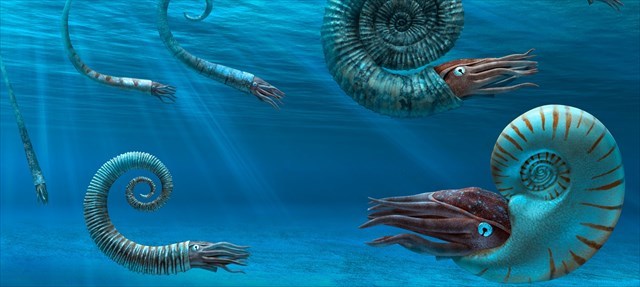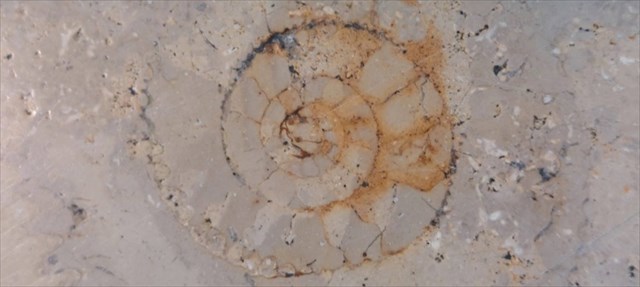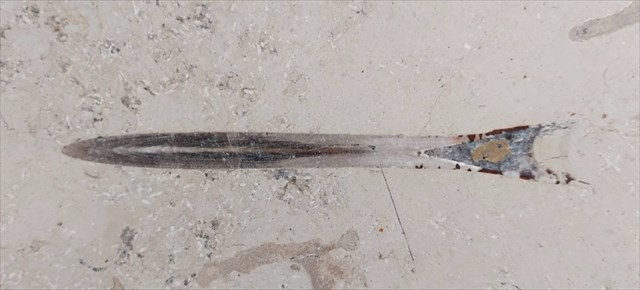|

 Dieser EarthCache zeigt Ihnen, dass Sie nicht nur an paläontologischen fundstellen nach fossilien suchen müssen. Dieser EarthCache zeigt Ihnen, dass Sie nicht nur an paläontologischen fundstellen nach fossilien suchen müssen.
 This EarthCache will show you that fossils are not only found in museums and paleontological sites. This EarthCache will show you that fossils are not only found in museums and paleontological sites.

Ammoniten / Ammonites
 Versteinerung eines Ammoniten, Verwandte der heute lebenden Tintenfische, aus der Sahara. Die Bezeichnung "Ammoniten" leitet sich von dem Namen des ägyptischen Gottes Ammon ab, der einen Widderkopf besaß. Das Skelett der Ammoniten ist also genauso spiralförmig gewunden wie die Hörner eines Widders. Bei den Ammoniten handelt es sich um eine ausgestorbene Gruppe von Kopffüßern, die etwa 350 Millionen Jahre lang in den Meeren lebte. Ihre Entwicklung begann im Devon mit den Altammoniten (Goniatiten) und führte über die Ceratiten-Formen des Trias zu den eigentlichen Ammoniten der Jura- und Kreidezeit, die in riesiger Formenfülle auftraten, bis sie vor 65 Millionen Jahren zusammen mit den Dinosauriern ausstarben. Die Ammoniten sind für die zeitliche Gliederung der Erdgeschichte von großer Bedeutung. Insgesamt wurden bis heute über 7000 Arten beschrieben. Heute sind die Kopffüßer durch die Tintenfische, Kalmare, Kraken und den Nautilus vertreten. Er trägt als einziger hiervon ein Gehäuse und ist der letzte lebende Vertreter der Nautiliden, einer Gruppe, die im frühen Erdaltertum ihre Blütezeit hatten. Versteinerung eines Ammoniten, Verwandte der heute lebenden Tintenfische, aus der Sahara. Die Bezeichnung "Ammoniten" leitet sich von dem Namen des ägyptischen Gottes Ammon ab, der einen Widderkopf besaß. Das Skelett der Ammoniten ist also genauso spiralförmig gewunden wie die Hörner eines Widders. Bei den Ammoniten handelt es sich um eine ausgestorbene Gruppe von Kopffüßern, die etwa 350 Millionen Jahre lang in den Meeren lebte. Ihre Entwicklung begann im Devon mit den Altammoniten (Goniatiten) und führte über die Ceratiten-Formen des Trias zu den eigentlichen Ammoniten der Jura- und Kreidezeit, die in riesiger Formenfülle auftraten, bis sie vor 65 Millionen Jahren zusammen mit den Dinosauriern ausstarben. Die Ammoniten sind für die zeitliche Gliederung der Erdgeschichte von großer Bedeutung. Insgesamt wurden bis heute über 7000 Arten beschrieben. Heute sind die Kopffüßer durch die Tintenfische, Kalmare, Kraken und den Nautilus vertreten. Er trägt als einziger hiervon ein Gehäuse und ist der letzte lebende Vertreter der Nautiliden, einer Gruppe, die im frühen Erdaltertum ihre Blütezeit hatten.
Das Gehäuse der Ammoniten war spiralförmig aufgerollt, aber im Unterschied zu den Gehäusen der Schnecken in zahlreiche Kammern gegliedert. Das Ammonitentier lebte nur in der äußersten Kammer, die eine Länge zwischen einer halben und eineinhalb Gehäusewindungen haben konnte. Die Wohnkammer war über einen Luftschlauch mit den übrigen Kammern verbunden. Durch Veränderung des Luftinhaltes konnte das Tier im Wasser auf- und absteigen. Beim Wachsen verlängerten die Ammoniten die Außenschale und zogen hinter sich eine neue Kammerswcheidewand ein. Dort, wo diese Wände mit der Außenschale zusammenwuchsen, bildeten sich Verwachsungsnähte, die Lobenlinien. Sie sind nur auf den Steinkernen der Ammonitengehäuse sichtbar. Sie stellen ein wichtiges Hilfsmittel zur Bestimmung der jeweiligen Art dar.
 Fossil of an ammonite, relative of the living cuttlefish, from the Sahara. The term "Ammonite" derives from the name of the Egyptian god Ammon, who had a ram's head. The skeleton of the ammonite is thus spirally wound like the horns of a ram. The ammonites are an extinct group of cephalopods that lived in the seas for about 350 million years. Their development began in the Devonian with the old ammonites (Goniatites) and led via the Ceratite forms of the Triassic to the actual ammonites of the Jurassic and Cretaceous periods, which appeared in a huge variety of forms until they died out together with the dinosaurs 65 million years ago. The ammonites are of great importance for the chronological structure of the earth's history. A total of over 7000 species have been described to date. Today the cephalopods are represented by the cuttlefish, squid, octopus and the nautilus. It is the only one with a shell and is the last living representative of the nautilids, a group that had its heyday in the early Palaeozoic period. Fossil of an ammonite, relative of the living cuttlefish, from the Sahara. The term "Ammonite" derives from the name of the Egyptian god Ammon, who had a ram's head. The skeleton of the ammonite is thus spirally wound like the horns of a ram. The ammonites are an extinct group of cephalopods that lived in the seas for about 350 million years. Their development began in the Devonian with the old ammonites (Goniatites) and led via the Ceratite forms of the Triassic to the actual ammonites of the Jurassic and Cretaceous periods, which appeared in a huge variety of forms until they died out together with the dinosaurs 65 million years ago. The ammonites are of great importance for the chronological structure of the earth's history. A total of over 7000 species have been described to date. Today the cephalopods are represented by the cuttlefish, squid, octopus and the nautilus. It is the only one with a shell and is the last living representative of the nautilids, a group that had its heyday in the early Palaeozoic period.
The shells of the ammonites were rolled up in a spiral, but in contrast to the shells of the snails, they were divided into numerous chambers. The ammonite lived only in the outermost chamber, which could be between half and one and a half whorls long. The living chamber was connected to the other chambers by an air hose. By changing the air content, the animal could ascend and descend in the water. As the ammonites grew, they lengthened the outer shell and drew in a new ventricular partition behind them. Where these walls grew together with the outer shell, weld seams formed, the lobe lines. They are only visible on the stone cores of the ammonite shells. They are an important tool for identifying the species.

Anatomie / Anatomy
 Die Grundform des Gehäuses von Ammoniten ist eine sich mit zunehmender Entfernung von der Öffnung (Apertur) verjüngende Röhre, die nach Art einer logarithmischen Spirale aufgerollt ist. Diese Grundform wird als planspiral bezeichnet. Weil ein entrolltes Gehäuse die Form eines Spitzkegels hätte, lautet die Lagebezeichnung für Körperteile, die zum Anfang der Spirale, dem Nabel, hin gelegen sind, adapikal (von lat. Apex ‚Spitze‘). Für Körperteile, die zum Ende der Spirale, zur Gehäusemündung (Apertur) hin gelegen sind, lautet sie adoral (von lat. oris ‚Mund‘) oder adapertural. Durch die spiralartige Windung umgreift die „innere“ (dorsale) Partie der Gehäuseröhre die „äußere“ (ventrale) Partie der nächstinneren Windung mehr (involutes Gehäuse) oder weniger (evolutes Gehäuse) stark.
Die Grundform des Gehäuses von Ammoniten ist eine sich mit zunehmender Entfernung von der Öffnung (Apertur) verjüngende Röhre, die nach Art einer logarithmischen Spirale aufgerollt ist. Diese Grundform wird als planspiral bezeichnet. Weil ein entrolltes Gehäuse die Form eines Spitzkegels hätte, lautet die Lagebezeichnung für Körperteile, die zum Anfang der Spirale, dem Nabel, hin gelegen sind, adapikal (von lat. Apex ‚Spitze‘). Für Körperteile, die zum Ende der Spirale, zur Gehäusemündung (Apertur) hin gelegen sind, lautet sie adoral (von lat. oris ‚Mund‘) oder adapertural. Durch die spiralartige Windung umgreift die „innere“ (dorsale) Partie der Gehäuseröhre die „äußere“ (ventrale) Partie der nächstinneren Windung mehr (involutes Gehäuse) oder weniger (evolutes Gehäuse) stark.
Vermutlich bedingt durch starke Meeresspiegelanstiege (Transgression) entstanden in der Obertrias, im Mitteljura und besonders häufig in der Kreidezeit „abnorm“ und zum Teil in alle Raumrichtungen entrollte Gehäuse. Solche Formen werden auch als aberrante oder heteromorphe Ammoniten bezeichnet. Einer der bekanntesten Vertreter dieser Formen ist Nipponites aus der Oberkreide Japans. Seine Gehäuseröhre besteht aus in sich verschlungenen U-förmigen Abschnitten und zählt zu den absoluten Raritäten. Ein weiteres Beispiel ist Diplomoceras, dessen Gehäuse wie eine Büroklammer geformt war.
 The basic form of the shell of ammonites is a tube that narrows with increasing distance from the opening (aperture) and is rolled up in the manner of a logarithmic spiral. This basic form is called a planspiral. Because an unrolled shell would have the shape of a pointed cone, the location designation for body parts that are located at the beginning of the spiral, the navel, is adapical (from the Latin apex 'point'). For parts of the body that are located towards the end of the spiral, towards the housing mouth (aperture), it is adoral (from Latin oris 'mouth') or adapertural. Due to the spiral-like turn, the "inner" (dorsal) part of the shell tube embraces the "outer" (ventral) part of the next inner turn more (involute shell) or less (evolute shell) strongly. The basic form of the shell of ammonites is a tube that narrows with increasing distance from the opening (aperture) and is rolled up in the manner of a logarithmic spiral. This basic form is called a planspiral. Because an unrolled shell would have the shape of a pointed cone, the location designation for body parts that are located at the beginning of the spiral, the navel, is adapical (from the Latin apex 'point'). For parts of the body that are located towards the end of the spiral, towards the housing mouth (aperture), it is adoral (from Latin oris 'mouth') or adapertural. Due to the spiral-like turn, the "inner" (dorsal) part of the shell tube embraces the "outer" (ventral) part of the next inner turn more (involute shell) or less (evolute shell) strongly.
In the Upper Triassic, in the Middle Jurassic and particularly frequently in the Cretaceous, probably due to strong rises in sea level (transgression), “abnormal” shells that sometimes unfurled in all spatial directions were formed. Such forms are also known as aberrant or heteromorphic ammonites. One of the best-known representatives of these forms is Nipponites from the Upper Cretaceous of Japan. Its case tube consists of intertwined U-shaped sections and is one of the absolute rarities. Another example is Diplomoceras, whose body was shaped like a paper clip.

Fossil / Fossiles
 Ein Fossil ist etwas, was von vergangenem Leben übrig geblieben ist. Fossilien findet man im Erdboden. Das Wort kommt von dem lateinischen Wort „fossilis“, das „ausgegraben“ bedeutet. Oft spricht man auch von Versteinerung, aber es gibt auch Fossilien, die keine Versteinerungen sind, zum Beispiel Erdöl. Die meisten Fossilien sind Überreste von Lebewesen, also von Pflanzen oder Tieren. Auch Eier oder Kot können zu Fossilien werden. Fußspuren von Tieren im Sand können sich über viele tausend Jahre erhalten und zu Fossilien werden. Dabei versteinert aber nicht das Lebewesen selbst, sondern eben nur sein Abdruck. Ein Fossil ist etwas, was von vergangenem Leben übrig geblieben ist. Fossilien findet man im Erdboden. Das Wort kommt von dem lateinischen Wort „fossilis“, das „ausgegraben“ bedeutet. Oft spricht man auch von Versteinerung, aber es gibt auch Fossilien, die keine Versteinerungen sind, zum Beispiel Erdöl. Die meisten Fossilien sind Überreste von Lebewesen, also von Pflanzen oder Tieren. Auch Eier oder Kot können zu Fossilien werden. Fußspuren von Tieren im Sand können sich über viele tausend Jahre erhalten und zu Fossilien werden. Dabei versteinert aber nicht das Lebewesen selbst, sondern eben nur sein Abdruck.
Die Wissenschaft, die sich mit Fossilien beschäftigt, ist die Paläontologie. Fossilien sind die beste und fast einzige Möglichkeit, etwas über ausgestorbene Lebewesen zu erfahren. Forscher haben schon weit über 100.000 fossile Arten von Lebewesen gefunden und untersucht. Es hat aber wahrscheinlich über eine Milliarde Arten gegeben. Doch von den meisten sind keine Überreste erhalten geblieben. Besonders bekannt sind Fossilien von Dinosauriern, Menschen, Bäumen und Ammoniten.
 A fossil is something left over from past life. Fossils are found in the ground. The word comes from the Latin word "fossilis" which means "unearthed". One often speaks of petrification, but there are also fossils that are not petrification, for example oil. Most fossils are the remains of living things, whether plants or animals. Eggs or feces can also become fossils. Animal footprints in the sand can persist for many thousands of years and become fossils. However, the creature itself does not petrify, only its imprint. A fossil is something left over from past life. Fossils are found in the ground. The word comes from the Latin word "fossilis" which means "unearthed". One often speaks of petrification, but there are also fossils that are not petrification, for example oil. Most fossils are the remains of living things, whether plants or animals. Eggs or feces can also become fossils. Animal footprints in the sand can persist for many thousands of years and become fossils. However, the creature itself does not petrify, only its imprint.
The science that studies fossils is paleontology. Fossils are the best and almost the only way to learn about extinct creatures. Researchers have found and studied well over 100,000 fossil species of living things. But there have probably been over a billion species. However, no remains have survived from most of them. Fossils of dinosaurs, humans, trees and ammonites are particularly well known.

Öffnungszeiten / Notice
 Finde die Antworten auf die Aufgaben im Einkaufszentrum Regensburg Arcaden. Hier sind die Öffnungszeiten. Finde die Antworten auf die Aufgaben im Einkaufszentrum Regensburg Arcaden. Hier sind die Öffnungszeiten.
Montag - Samstag 9:30 - 20:00
Sonntag abgeschlossen  Find the answers to the tasks in the Regensburg Arcaden shopping center. Here are the opening hours. Find the answers to the tasks in the Regensburg Arcaden shopping center. Here are the opening hours.
Monday - Saturday 9:30 - 20:00 Sunday closed
 Um log als "gefunden" anzumelden, musst du mir über mein Profil eine E-Mail senden und Antworten auf die folgenden Fragen und Aufgaben senden: Um log als "gefunden" anzumelden, musst du mir über mein Profil eine E-Mail senden und Antworten auf die folgenden Fragen und Aufgaben senden:
1) Gehe durch alle Etagen des Einkaufszentrums, finde den größten Ammoniten und messe seinen Durchmesser in Zentimeter.
2) Wie sind die Fossilien einst entstanden?
3) Neben Ammoniten sind auch andere Fossilien zu sehen. Finde mindestens zwei und beschreibe sie. Optional (ist nicht Bestandteil der Bedingung) kannst du mir auch einen Namen schreiben.
4) Mache ein Foto von dir oder deinem GPS mit einem der Ammoniten und lade das Foto mit dem Log hoch.
 For log as "found it" please send me answers for those questions via my profile: For log as "found it" please send me answers for those questions via my profile:
1) Go through all floors of the mall, find the largest ammonite and measure its diameter in centimeters.
2) How were the fossils formed?
3) In addition to ammonites, other fossils can also be seen. Find at least two and describe them. Optionally (is not part of the condition) you can also write me a name.
4) Take a picture of you or your GPS with one of the ammonites and upload the picture to the the log.
 Bitte sende deine Antworten per E-Mail über mein Profil und logge diesen EarthCache. Falls es ein Problem mit deinen Antworten geben sollte, so melden ich mich, um es zu lösen. Bitte sende deine Antworten per E-Mail über mein Profil und logge diesen EarthCache. Falls es ein Problem mit deinen Antworten geben sollte, so melden ich mich, um es zu lösen.
 Please email your answers through my profile and log this EarthCache. If there's a problem with your answers, I'll get in touch to solve it.. Please email your answers through my profile and log this EarthCache. If there's a problem with your answers, I'll get in touch to solve it..

|